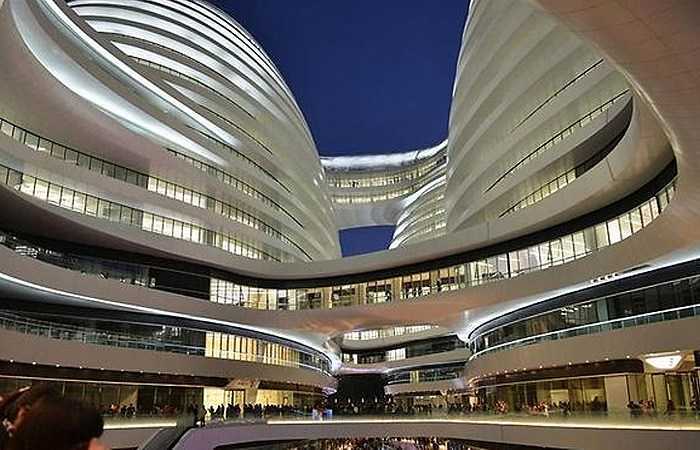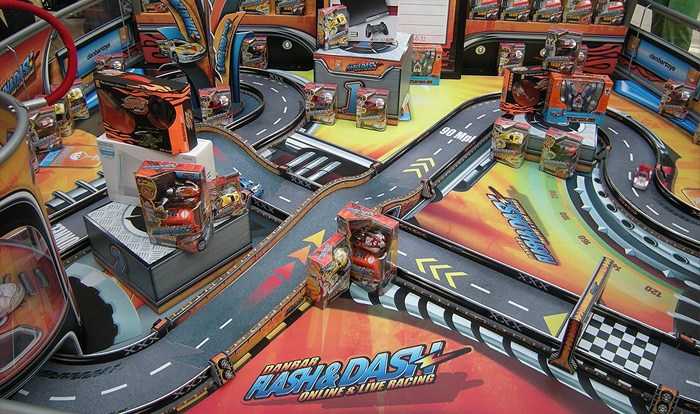The following article, published by Ynet, one of Israel’s leading online news services, provides an overview of new, innovative shopping malls around the world, which are a stark contrast to Israel’s staid, boring shopping malls. Lior Koren was interviewed for the article as an expert in commercial design.

Store windows that are actually touchscreens, shopping malls where shoppers reserve parking spaces via smartphone, a play area whose toys are for sale and shopping malls that also have a water park and a church. In Israel, shopping malls are usually just a collection of shops that all feature the same brands – and today, when people can shop online, Israeli malls are boring.
One San Francisco shopping mall, owned by the Westfield group, decided to experiment by collaborating with eBay. Large touch screens were installed on glass panels in the mall’s empty spaces. Three chains – TOMS, Rebecca Minkoff and Sony – accepted the challenge to display their merchandise on these Internet-connected screens in the mall.
Passersby use their fingers to scroll through the collections and order items by entering their cellphone numbers. Even if the hybridization between a glass panel and a tablet seems strange to us it likely won’t be the main aspect of modern shopping malls, since it’s unlikely people will be willing to spend time in the car, possibly even getting stuck in traffic, just to buy something online. However, for the aforementioned chains it’s an interesting experiment. The first two chains don’t have a physical store in this particular mall and the experiment, which runs until January 12, 2014, saves them on rent and other costs; at the same time, they can assess whether consumers are interested in their brand. For consumers, these touchscreens are something new and interesting, an attraction. For the mall, this kind of display is innovative and draws on concepts from “pop up” stores – temporary stores that have been popping up in malls in recent years to provide shoppers with alternating attractions.
The Westfield Group launched a website in Australia to simulate its shopping mall there, so that the consumer could browse through the stores online. In addition, Westfield is planning this month to install sensors in its malls’ parking lots: the shopper, online or using a smartphone, can “enter” the parking lot and reserve a parking space before setting out for the mall. Could there be any easier way to get to the mall?
Israeli Malls are Quite Boring
Malls can no longer be just places to shop, particularly because their customers shop online. The trend over the past decade has been to turn malls into amusement parks to provide an experience that cannot be had online. A Dubai mall constructed an enormous aquarium and an indoor ski area, while Berlin’s Europa Center offers a helicopter flight-simulation over the city. In Minnesota’s Mall of America there is a golf course and a church, where weddings are held. The West Edmonton Mall in Canada houses an enormous water park. A Chinese mall, Galaxy SOHO, was launched a year ago that also contains restaurants and office space and was designed by the British architect, Zaha Hadid. The New South Mall, in China as well, covers 700,000 sq. m. (173 acres) and has seven sections, each one designed to look like a different city, e.g., Paris, Venice and Cairo.
It’s not surprising that these shopping malls were built in wealthy countries whose consumers quickly get bored, and when boredom sets in the abundant wealth is invested in grandiose and bombastic shopping centers. Huge shopping malls, in particular, tend to have areas that visitors never pass through. They do, however, indicate developing trends for shopping malls. In Israel, just like in other countries, over the long run shopping malls won’t be profitable solely based on clothing stores.
Now, think of the mall closest to your house. It has a national coffee chain branch and various clothing stores, like Zara, H&M, Castro and Fox [translator’s note: two Israeli fashion chains]. You love these chains, but there has long been a feeling in the industry that there are too many malls and maybe you also feel that all the malls in Israel look the same. Most of them are composed of several corridors along one or more stories and each one offers the same experience, with only minor differences.
Even the Mamilla Mall [translator’s note: a shopping mall in Jerusalem next to the historic Old City] that occupies preserved, historic buildings has the same chains that can be found in any Israeli mall and even the new Sharona Mall, which will soon open in Tel Aviv and intends to break out of the formula of the regular Israel mall, will have a branch of Laline [an Israeli body care chain]. When every resident has at least two malls to choose from, the question is which mall offers more interesting options and services? Sometimes the choice is that one mall has a Forever 21 and the other one does not. Eventually though, it’s all a bit boring.
This week it was announced that Bangkok’s shopping center, Siam Paragon, which also includes an opera and a giant aquarium, was the most photographed location on Instagram in 2013. In Israel, however, shopping malls don’t generally provide any experience other than shopping.
Retail stands are transforming malls
According to Lior Koren, an industrial designer and the owner of Koren Visual Solutions, malls are boring because the main experience they provide is the simulation of a street. “The architect, developer and management – all of them are street-oriented. This means that the stores must stay located in little boxes, with a passageway between them, but who ever said that a street is an interesting experience? It’s anachronistic and is less suitable to today’s shopping experience of shopping online. Innovations are always built similarly to the things they are replacing. Just like the first cars resembled carriages, so too do shopping malls look like streets, but it’s boring, so malls add things like reading corners, play areas and retail stands.
“A reading corner does not make people shop. It doesn’t help the shopping mall. A play area also will not necessarily lead to sales and each mall needs that every consumer will leave after making a purchase of at least 75 NIS [~$21/~€15]. Retail stands, however, sell more than stores because they are more accessible and are on the shopper’s route as he walks around. They aren’t necessarily attractive from an architectural standpoint but at our company we think that removing stores’ display windows improves the shopping experience and leads to higher sales.
“Magnolia [an Israeli jewelry chain] knows that retail stands sell more than stores, so for their store in the Cinema City mall in Rishon Le’Zion , they rented a corner location, removed the display windows and this particular store’s sales are the same as those of a retail stand. It’s phenomenal how much the closed look of a store negatively impacts them. Retail stands today do not sell low-quality, cheap merchandise – look at Marcha Ballerina and Carolina Herrera [both sold at retail stands in Israel]. Retailers can find entire categories to occupy an aisle.
“Malls worldwide have retails stands for some of the biggest and most high-end companies. Retails stands try new categories to sell more, because the entrance to a store is difficult and expensive. Malls want stores’ earnings to increase, so they really need to help their retailers provide a more interesting experience in one way or another.”
 The Magnolia store in the Cinema City mall. A store that feels like a retail stand because stands sell more.Photo courtesy of Lior Koren
The Magnolia store in the Cinema City mall. A store that feels like a retail stand because stands sell more.Photo courtesy of Lior KorenLondon: You can buy the toys you played with!
Koren thinks that malls’ attractions should be more than just diversions and should actually encourage shoppers to buy. Attractions may be nice for shoppers but they do nothing for retailers. In Great Britain, Koren Visual Solutions designed and built play stands for a toy company that sells remote-controlled cars. These play stands, which have been set up in 18 shopping malls, sell tickets for a remote-controlled car game and also retail these same cars at the stands. These stands are essentially play areas, where the equipment and toys do not belong to the mall and can actually be purchased.
 Playing and buying. Retail stands in London mallsPhoto courtesy of Lior Koren
Playing and buying. Retail stands in London mallsPhoto courtesy of Lior Koren“Shopping becomes an experience and the consumer connects personal quality time with shopping,” Koren explains. “Attractions that have no connection to the shopping experience may attract consumers, but they harm sales. Take, for example, the Tel Aviv Nike Run – lots of people come to Tel Aviv, but the stores do not make any money. Why? Because the experience is not related to shopping.
“In Andorra, there is a mall in the middle of the way up the mountain, so to reach the ski resort’s chairlift you have to go by the mall. Of course, all the stores are connected to skiing or tourism. The Jaffa Port could have been a series of standard restaurants but the port’s management created an experience of little stalls that look out on the water. People come just for the experience of wandering in and out of the stalls. The Tel Aviv Port has the closed market building, which is an attraction. None of the businesses individually would have created this on its own. The developer is not an active operator.”
Learn from Cinema City and the Mall of America
According to Koren, innovation occurs mainly when the developer is the mall’s primary consumer. “Take, for example, the very successful Cinema City mall in Rishon Le’Zion, which is built around the mall’s anchor: the movie theaters. All the stores are related to and surround the theaters. You won’t find a Fendi store there because it does not fit in, but there is a jewelry store aimed at young women.
“Even the Mall of America has a similarly unique concept. Its developers are a Jewish-Iranian family. They have two malls and are currently building a third, which will be the world’s largest, in New Jersey. What they actually did was to build a huge theme park with the mall surrounding it. Everything revolves around a specific theme, which focuses the mall’s entire experience. An endless collection of streets, that’s boring. Stores to the right, stores to the left, there’s not much left to play around with in a mall. The mall needs to be part of a larger experience. When the experience offered by the mall is strong and unique it’s easy to connect the mix to the experience.”